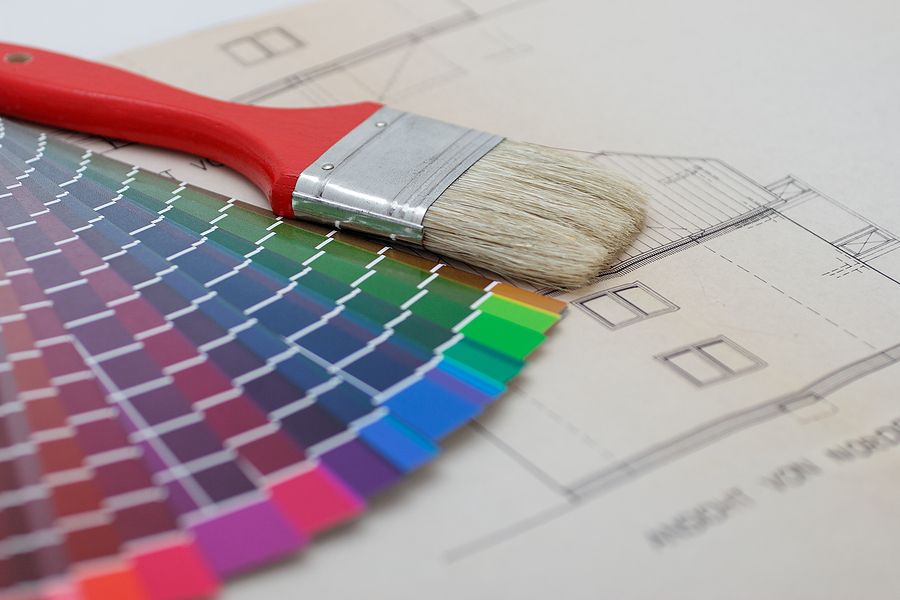
Choosing the Best Paint Color for Small Bathrooms
The color scheme of your bathroom can greatly impact its perception of space and overall ambiance. When dealing with small bathrooms, choosing the right paint color becomes even more important, as the right shades can create an illusion of a larger, airier space. This blog will guide you through selecting the best paint color for your small bathroom.
Understanding the Role of Colors
Before delving into specific colors, it’s important to understand how colors can influence the perception of space. Light colors, especially shades of white, cream, and pastels, are known for making rooms appear larger and brighter because they reflect light better. Dark colors, while sophisticated and dramatic, can make a small space feel even more confined.
Light and Neutral Colors
- White
This is the most common choice for small bathrooms because it offers a clean, fresh look and reflects light well, making the room appear larger. But white doesn’t mean boring. There are many shades to choose from – crisp white, off-white, or a white with undertones of other colors.
- Beige
Beige is a great neutral color that adds a bit more warmth compared to white. It’s perfect for those who want a cozy yet light atmosphere in their small bathroom.
- Light Gray
A light gray color scheme offers a contemporary look without the starkness of pure white. It also pairs well with most bathroom fixtures.
- Soft Pastels
Pastel colors such as soft pink, mint green, or light blue can add a gentle pop of color to your bathroom without overwhelming the space. They still retain the light-reflecting properties that help to open up the space.
- Dark and Bold Colors
While lighter colors are traditionally recommended for small spaces, dark colors can work well if used correctly. A deep blue or forest green, for example, can create an intimate, cozy feeling. However, when using dark colors, consider balancing them with lighter fixtures or accents to avoid making the bathroom feel too small.
- Accent Walls
If you’re hesitant to commit to a bold color throughout the entire bathroom, consider an accent wall. Painting one wall in a bold color can create a focal point and add character to the space without overwhelming it.
Consider the Bathroom Lighting
The amount and type of lighting in your bathroom can significantly impact how a paint color looks. Bathrooms with little natural light might benefit from lighter, more reflective colors, while bathrooms with plenty of natural light can handle darker or bolder colors.
Test Before You Commit
Paint colors can look very different on the swatch or in the can compared to on your walls. So, before you commit to a color, buy a small can of the paint color you’re considering and apply a small swatch on your bathroom wall. Observe it at different times of the day to see how it changes with different lighting conditions.
Choosing the best paint color for your small bathroom is about balance. The right color can enhance the feeling of space while reflecting your personal style. Whether you choose a light, airy color, a bold, dramatic shade, or something in between, ensure it’s a color you love and that it creates a space where you feel comfortable and relaxed.

The Best Shade of Paint for a Bathroom with No Windows
Bathrooms without windows present a unique challenge when it comes to selecting the best bathroom paint colors. These spaces lack the benefit of natural light, which can significantly alter the perception of color. Here are some recommendations for the best shades to use in a small windowless bathroom.
Embrace the Light
Without natural light, your bathroom will rely heavily on artificial light sources. For this reason, it is often best to lean towards lighter, bright colors that can reflect light effectively, creating a more open and airy feel.
- White: You can’t go wrong with white bathrooms. White is the most reflective color, making it an excellent choice for spaces lacking in natural light. From crisp, pure white to off-white or whites with undertones of other colors, you can pick the shade that suits your aesthetic the best.
- Pastels: Just like white, pastel colors are light reflectors. Soft shades of blue, green, or pink can add a hint of color without overpowering the room or making it feel smaller.
Adding Warmth with Neutrals
If white feels too stark for you, consider warm neutral colors. These can add a bit more depth and coziness without making the space feel cramped.
- Beige: Beige, especially a light, sandy version, can add a warm, cozy touch to your bathroom. Pair it with white fixtures for a classic, timeless look.
- Light Gray: A soft gray color can bring a contemporary and elegant touch to a windowless bathroom. It pairs well with chrome or silver fixtures and can be complemented with white or colored accents.
When To Go Dark
Even without windows, dark colors can work in a bathroom if used wisely. Darker shades can add depth and richness to a space, but in windowless bathrooms, it’s best to use them as accents rather than the main color.
Finish with Gloss
In bathrooms without natural light, choosing paint with a satin or semi-gloss finish can be beneficial. The glossier finish helps to reflect artificial light around the room, creating a brighter, more open feel.
Selecting the best color for a bathroom with no windows involves considering your artificial lighting and using colors that enhance the available light. Whether you opt for bright whites, soft neutrals, or even bold darks, remember that the best bathroom paint color is one that creates a space where you feel comfortable and suits your personal style.
The Best Paint Finish for a Bathroom
The finish of the paint you select for your bathroom is almost as important as the color. Given the unique environment in a bathroom – with its high moisture levels and frequent cleaning – you’ll need a paint finish that can withstand these conditions while looking great. Let’s look at the different paint finishes available and evaluate their suitability for bathrooms.
- Flat or Matte Finish: Flat or matte finish paints offer a non-reflective appearance and are great at hiding minor wall imperfections. However, they’re not the best choice for bathrooms because they absorb moisture, which can lead to mold and mildew growth. Also, they’re not as easy to clean as paints with glossier finishes.
- Eggshell Finish: Eggshell paint has a low sheen that’s somewhat akin to the surface of an eggshell. It’s more washable and slightly more resistant to moisture than flat paint, but it may not hold up to the high-moisture environment in a bathroom as well as other finishes.
- Satin Finish: Satin finish paint is a popular choice for bathrooms. It has a smooth, silky appearance with a moderate sheen. It resists mildew effectively and stands up to cleaning, which makes it a good choice for a bathroom’s challenging environment.
- Semi-Gloss Finish: Semi-gloss paint finish is even more durable and easy to clean than satin. It stands up well to moisture, making it a good choice for areas that come into contact with water, such as the area around the sink or bathtub. Its slightly glossy appearance can highlight imperfections on the wall, though, so surface preparation is crucial.
- High-Gloss Finish: High-gloss paint finishes are the most durable and easiest to clean, but they’re rarely used throughout a bathroom because they can create a very shiny, almost plastic-like appearance. They’re often used for trim and cabinets rather than walls.
When choosing a paint finish for your bathroom, you need to balance aesthetics with practicality. Satin and semi-gloss finishes are generally the best choices for bathrooms due to their durability, resistance to moisture, and ease of cleaning. However, it’s always a good idea to speak to a paint professional or consultant to help you choose the best paint finish for your specific situation and preferences. Remember that regardless of the finish you choose, good ventilation is key to preventing excessive moisture buildup that can damage your bathroom walls over time.

Top 10 Best Paint Brands in 2023
Choosing the right paint for your bathroom goes beyond just color and finish. The quality of the paint you use is just as important. The best paint brands offer high-quality products that apply easily, cover well, and stand up to cleaning and wear. Here are the top 10 best paint brands in 2023.
1. Benjamin Moore
A highly respected and widely recognized brand, Benjamin Moore offers a broad range of colors and finishes. Their paints provide excellent coverage and durability, making them a popular choice for bathrooms.
2. Sherwin-Williams
Sherwin-Williams offers a wide array of high-quality paints with excellent coverage and durability. Their bathroom-specific line, like the Emerald Interior Acrylic Latex Paint, offers great moisture and mildew resistance.
3. Behr
A go-to brand for many DIYers, Behr offers high-quality paint at a reasonable price. Their Premium Plus Interior Enamel line is well-regarded for its durability and easy application.
4. Valspar
Valspar offers a wide range of color options and finishes. Their Signature Scuff Shield Technology line is known for its excellent coverage and resistance to wear and tear.
5. PPG
PPG is known for its innovative paint solutions. Their Pure Performance Paint & Primer is a low-VOC paint, providing great coverage and durability while being environmentally friendly.
6. Dulux
Dulux paints are known for their quality and durability. Their Bathroom+ line is specially formulated for bathrooms and offers a mold and mildew resistant finish.
7. Farrow & Ball
For those seeking high-end, designer paint, Farrow & Ball is a great choice. Their paints are richly pigmented, offering unique depth of color and excellent durability.
8. Pratt & Lambert
Pratt & Lambert offer a wide range of premium quality paints. Their Accolade Interior Paint + Primer offers superb coverage, adhesion, and durability, making it a good choice for bathrooms.
9. Glidden
Glidden offers high-quality paints at a more budget-friendly price point. Their Premium Interior Paint + Primer is known for its excellent coverage and resistance to wear.
10. Rust-Oleum
While Rust-Oleum is often associated with specialty paints, they also offer a range of interior paints. Their Zinsser Perma-White Mold & Mildew-Proof Interior Paint is a top performer in bathrooms.

Selecting a reputable paint brand is crucial to ensuring a great finish and long-lasting results. Benjamin Moore, Sherwin-Williams, Behr, and other brands on this list have built a strong reputation based on the quality and performance of their products. Choosing the right brand for your project comes down to considering your specific needs, budget, and color preferences.
How Paint Can Change the Way a Room Feels
The color of paint you choose for your bathroom can drastically alter the atmosphere and overall feel of the space. The right hue can open up a small bathroom, make a sterile space feel cozy, or turn an old-fashioned bathroom into a modern sanctuary. Let’s look at how different paint colors, such as pale yellow, blue, and white, can transform your bathroom.
Pale Yellow Paint
A pale yellow paint color can add warmth and brightness to a small or windowless bathroom. Yellow is often associated with joy and positivity, which can make your bathroom feel inviting and uplifting. Pale yellow pairs beautifully with white fixtures and accents for a classic, timeless look, or with darker colors like navy blue or black for a more contemporary feel.
Blue Paint Color
Blue is a versatile color that can bring a range of feelings to your bathroom, depending on the shade. Lighter, pastel blues can give the space a tranquil, serene vibe, similar to a spa. They can also make the bathroom feel more spacious.
Darker shades of blue, like navy or cobalt, can add depth and sophistication to the room. Blue is often associated with cleanliness, making it an ideal choice for a bathroom. A blue bathroom can feel like a refreshing oasis, a calm retreat, or a luxurious powder room, depending on how you use the color.
White Bathrooms
White paint can make a bathroom feel clean, crisp, and bright. White bathrooms are timeless, providing a blank canvas that you can accent with any color. Because white reflects light, it can make a small bathroom feel more spacious. Moreover, white creates a sense of cleanliness and freshness – essential feelings for a bathroom.
But a white bathroom doesn’t have to be sterile or boring. You can use different shades of white, or mix white with different textures and patterns, to add interest and depth. For example, a white bathroom with shiplap walls or subway tile can feel modern and rustic at the same time.
Choosing the right paint color can greatly enhance the atmosphere of your bathroom. Whether you opt for a pale yellow for a warm, cheery feel, a versatile blue for a tranquil oasis, or crisp white for a fresh, spacious feel, the color you choose can make your bathroom a space you enjoy spending time in. Remember, the best color for your bathroom is the one that makes you feel good. So don’t be afraid to experiment and make the space truly your own.
Using Light Fixtures and Paint to Make Your Small Bathroom Appear Larger
Small bathrooms can often feel cramped or confined, but there are design tricks you can use to create the illusion of more space. Two of the most effective methods involve the strategic use of paint and light fixtures. Here are some tips on how you can employ these elements to make your small bathroom appear larger.
The Magic of Paint
- Use Light Colors: Light colors, especially whites and pastels, reflect light and can make a room feel airy and spacious. Consider painting the walls, ceiling, and even the floor in a light color to open up the space.
- Paint the Ceiling a Light Color: If you prefer to have a bit of color on your walls, try painting the ceiling white or a lighter shade of the wall color. This can draw the eye upward and give the illusion of a higher ceiling.
- Continuous Color: Consider using the same color paint on the walls and ceiling. This creates a seamless look that avoids breaking up the space, which can make the room feel larger.
- Use Vertical or Horizontal Stripes: Stripes can visually expand the space in the direction they run. Vertical stripes can make the ceiling appear higher, while horizontal stripes can make the room appear wider.
The Power of Light Fixtures
- Use Mirrors: While not technically a light fixture, mirrors can reflect light and visually double your space. Consider placing a large mirror above the sink or opposite a window if you have one.
- Add More Lighting: Well-lit rooms tend to feel more spacious. Consider installing recessed lighting or a small chandelier to increase the overall lighting. If your bathroom has no windows, try to replicate natural light with daylight bulbs.
- Sconces on the Walls: Sconces save space and can add a nice ambiance. Placing a pair on either side of your mirror can provide flattering, even light for the vanity area.
- Use Clear Glass for Fixtures: Whether it’s a clear glass pendant light or a transparent shower enclosure, using clear glass can open up the space and allow light to move freely.
With the strategic use of paint and light fixtures, you can create the illusion of more space in your small bathroom. Use these tips as a starting point, and don’t be afraid to experiment with different techniques that suit your personal style and the specific layout of your bathroom. Remember, the goal is to create a space that feels open, airy, and comfortable for you.

The Rise of Gray: Trending and Popular Paint Colors
Gray has made a name for itself as a versatile and sophisticated choice in interior paint design, gaining popularity in recent years. It’s a neutral color, yet it comes in a wide range of shades that allow for diverse design opportunities. Whether you prefer a cool, modern aesthetic or a warm, rustic vibe, there’s a gray shade that can make your vision come to life. Let’s explore some of the most popular gray paint colors in 2023.
1. Benjamin Moore Stonington Gray (HC-170)
Stonington Gray is a cool, airy gray with blue undertones. It can bring a modern and clean look to any bathroom. It pairs beautifully with white trim and fixtures.
2. Sherwin-Williams Repose Gray (SW 7015)
Repose Gray is a light, slightly warm gray that’s versatile enough to work in nearly any space. It has a comforting and calming feel, making it a great choice for bathrooms.
3. Farrow & Ball Pavilion Gray (No. 242)
Pavilion Gray is a cool mid-tone gray with a subtle blue undertone. It’s classy, sophisticated, and serene, making it perfect for creating a tranquil bathroom environment.
4. Behr Dolphin Fin (790C-3)
Dolphin Fin is a gentle and soothing gray that tends to lean towards the cooler side. It’s a versatile gray that works well in a variety of spaces and lighting conditions.
5. Benjamin Moore Chelsea Gray (HC-168)
Chelsea Gray is a warm, rich gray that can give your bathroom a cozy and inviting feel. This shade works well in both traditional and modern spaces.
6. Sherwin Williams Dorian Gray (SW 7017)
Dorian Gray is a medium-light gray with a slight warm undertone. It can add depth and sophistication to your bathroom without being too overpowering.
7. Valspar Tempered Gray (4004-1A)
Tempered Gray is a cool, very light gray that almost has a lavender undertone. This color is delicate and soft, perfect for a serene bathroom setting.
8. Farrow & Ball Down Pipe (No. 26)
Down Pipe is a dark lead gray with blue undertones. This is a dramatic, deep gray that can create a stunning and luxurious bathroom space.
Gray continues to trend in 2023, with more people appreciating its ability to create different moods and styles. Whether you’re drawn to airy light grays or rich, deep hues, there’s a gray paint color that can enhance the beauty and comfort of your bathroom. Experiment with samples and observe how they change under different lighting conditions to choose the perfect gray for your space.
The Cost of Hiring Professional Painters
Hiring professional interior house painters can greatly enhance the look and feel of your home. The cost of hiring painters can vary depending on various factors, such as the size of the project, the complexity of the work, the location, and the experience of the painters. Here are some general pricing estimates to give you an idea of what to expect:
- Per Square Foot: Many painters charge per square foot of painting area. On average, the cost can range from $1 to $3 per square foot. This estimate includes the labor, materials, and surface preparation.
- Hourly Rate: Some painters charge an hourly rate, typically ranging from $20 to $50 per hour. The number of hours required for the project will depend on the size and scope of the work.
- Fixed Rate: For larger projects, painters may offer a fixed rate based on the overall scope of the project. This can range from a few hundred dollars for a small room to several thousand dollars for an entire house.
- Additional Costs: Keep in mind that there may be additional costs involved, such as paint supplies, primer, and any necessary repairs or surface preparation. These costs should be discussed with the painters during the initial consultation.
It’s important to note that these estimates are general guidelines and actual pricing may vary. It’s always a good idea to request quotes from multiple painters and compare their prices, experience, and customer reviews. This will help you make an informed decision and ensure you’re getting a fair price for the quality of work you desire.
Embracing Dark Paint Colors: A Perfect Choice for Interior Designers
When it comes to designing a bathroom, many interior designers are embracing the allure of dark paint colors. While light and neutral tones have long been favored for creating a sense of openness, using dark hues can be a great way to make a bold statement and add depth to the space. Pairing dark paint colors with white tiles can create a striking contrast and elevate the overall aesthetic of your bathroom. Here’s why dark paint colors can be a perfect choice and the best way to achieve a stunning bathroom design.

Creating Drama and Elegance
Dark paint colors, such as deep grays, rich blues, or even blacks, have the ability to create a sense of drama and elegance in a bathroom. They provide a unique and sophisticated backdrop that immediately catches the eye. Using a dark paint color on the walls can transform the space into a stylish sanctuary, offering a level of luxury and opulence.
Accentuating White Tiles
White tiles have long been a staple in bathrooms due to their timeless and clean look. When paired with dark paint colors, they create a striking contrast that instantly captivates. The dark walls can make the white tiles pop, highlighting their intricate details and creating a visual focal point. This combination can add depth and dimension to the room, making it visually engaging and aesthetically pleasing.
Playing with Light and Shadow
Dark paint colors have a unique ability to play with light and shadow. When combined with proper lighting fixtures, they can create a sense of intimacy and coziness. Well-placed light sources can illuminate the room while casting intriguing shadows against the dark walls, adding visual interest and depth. This interplay of light and shadow adds another layer of sophistication and allure to the overall design.
Considerations for Small Bathrooms
While dark paint colors can be a great choice for bathrooms of any size, they are particularly effective in small spaces. Contrary to popular belief, dark hues can make a small bathroom appear larger by blurring the edges of the space, creating an illusion of more depth. By incorporating adequate lighting and strategically placing mirrors, you can enhance this effect and create a visually stunning and spacious bathroom.
Embracing dark paint colors in your bathroom design is a bold and sophisticated choice that can transform the space into a true sanctuary. When combined with white tiles, it creates a visually striking contrast that adds depth and elegance. By considering lighting, shadows, and the overall design of your bathroom, you can achieve a stunning and unique aesthetic. So don’t shy away from the allure of dark paint colors – they may be the perfect choice to elevate your bathroom design to new heights.
